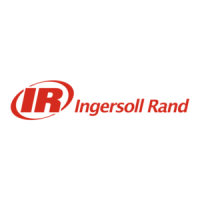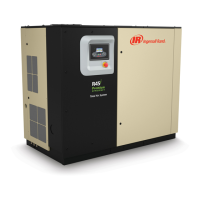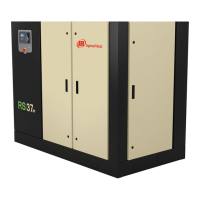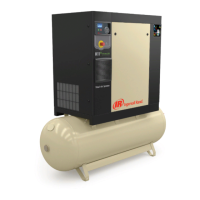EN
EN-8 80447162 Rev B
Water-cooled
Cooling Water Piping
NOTICE
Water piping to and from the compressor package shall be at least
as large as the package connection size. Do not undersize the water
piping.
Isolation valves with side drains should be installed on both the inlet and
outlet lines. To maintain cooler cleanliness and reliability, it is important to
install a strainer of 2 mm mesh size on the inlet line. Strainers are available
from Ingersoll Rand.
For sea water applications (sea water option only) a zinc anode is not
recommended as it will deteriorate the copper oxide lm on the 70/30
copper-nickel alloy tubes in contact with sea water. To minimize galvanic
corrosion and provide the greatest corrosion protection to the coolers, it
is strongly recommended that a section of iron pipe (>00 mm length) be
connected as close as possible to the air compressor package water inlet
connection. The iron pipe will act as the sacri cial anode for the copper-
nickel tubes and therefore shall be considered a regular maintenance and
replacement item. For this reason, the section of iron pipe should be installed
so that it can be easily replaced (e.g. with a union joint.).
The air compressor has a normally closed solenoid valve that is tted to
the water outlet side within the package. The valve is wired into the air
compressor control circuit and closes when the compressor stops.
Carefully inspect the water system before installing the air compressor
package. Ensure that the piping is free of scale and deposits that may
restrict water ow to the air compressor package. If water cleanliness is poor,
ltration installed on the water inlet pipe line is recommended.
Proper operation of the compressor requires that the cooling water ow
be provided at a maximum supply temperature of 46 °C (115 °F). See the
compressor engineering data sheets for cooling water ow rates.
Water temperature and pressure gauges should be installed in the water
piping for use in any fault nding of the water system. Water pressure should
ideally be between and 5 bar (43 .5 and 72.5 psi) but shall not be above
10 bar (145 psi).
Water cleanliness is also extremely important. Cleaning of coolers as a result
of fouling is a customer responsibility. Therefore, it is highly recommended
that proper water quality shall meet the requirements listed in WATER
QUALITY RECOMMENDATIONS later in this section.
Venting the water system
Air should be vented from the water side of the system to avoid poor
performance and water hammer. Since the air compressor uses di erent
type heat exchangers depending on your selection of “fresh water cooled”
or “harsh water cooled” system, the venting procedure is di erent. Be sure to
use the correct procedure below:
Fresh water coolers (brazed plate heat exchangers):
Disconnect the water stop valve in the water outlet line of the
compressor.
Open the inlet water valve(s) to allow the water to ow to the
compressor.
Allow all the air to escape from the system and observe water at the
water outlet port.
Connect the water stop valve.
Harsh water coolers (shell and tube heat exchangers):
Locate the water system vent cocks on top of the after-cooler and oil
cooler.
Open the water valve(s) allowing water to ow to the package.
Open the vent cocks and allow all air to escape from the system. When
water is observed at the vent cocks, close them.
1.
2.
3.
4.
1.
2.
3.
Draining the water system
Should it become necessary to completely drain the water system, use the
following procedures speci c to the water cooled option you have.
Fresh water coolers (brazed plate heat exchangers):
Disconnect the inlet water line from the connection located at the rear
of the compressor.
Disconnect the water stop valve in the water outlet line of the
compressor.
Allow the system to completely drain.
Harsh water coolers (shell & tube heat exchangers):
Disconnect the inlet and discharge water lines from the connections
located at the rear of the compressor.
Locate the after-cooler and oil cooler. Remove the drain plugs located
at the bottom of the coolers.
Open the vent ports in the top of the after-cooler and oil cooler.
Allow the system to completely drain.
Adjusting the after-cooler trim valve
See the piping and instrumentation diagram provided separately from this
manual. The coolers are piped in a “parallel” water ow arrangement with a
manual trim valve controlling the ow through the after-cooler. The after-
cooler trim valve is factory set and should not need adjusting but if disturbed
use following procedure.
Close valve fully clockwise and then open two full turns.
With the compressor running loaded observe the package discharge
temperature on the controller display. It should be approximately 8 °C
(15 °F) above the water inlet temperature.
If the temperature is too high, open the valve ¼ turn and wait one
minute. If the temperature is too low, close the valve ¼ turn and wait
one minute. Repeat the incremental movements until the desired
temperature is reached.
Put a “Warning − Do Not Adjust” label on the valve or t a lock.
Water quality recommendations
Water quality is often overlooked when the cooling system of a water-
cooled air compressor is examined. Water quality determines how e ective
the heat transfer rate, as well as the ow rate, will remain during the life of
the compressor. It should be noted that the quality of water used in any
cooling system does not remain constant during the operation of the system.
Evaporation, corrosion, chemical and temperature changes, aeration, scale
and biological formations a ect the water makeup. Most problems in a
cooling system rst appear as a reduction in the heat transfer rate, then in a
reduced ow rate or increased pressure drop, and nally with damage to the
system.
Scale: Scale formation inhibits e ective heat transfer, yet it does help
prevent corrosion. Therefore, a thin uniform coating of calcium carbonate
is acceptable on the inner surface. Perhaps the largest contributor to scale
formation is the precipitation of calcium carbonate out of the water. This is
dependent on temperature and pH level. The higher the pH value, the greater
the chance of scale formation. Scale can be controlled with water treatment.
Corrosion: In contrast to scale formation is the problem of corrosion.
Chlorides cause problems because of their size and conductivity. Low pH
levels promote corrosion, as well as high levels of dissolved oxygen.
Fouling: Biological and organic substances (slime) can also cause problems,
but in elevated temperature environments such as cooling processes they
are not a major concern. If they create problems with clogging, commercial
shock treatments are available.
To ensure good operation life and performance of the compressor cooling
system, the recommended acceptable ranges for di erent water constituents
are included below:
1.
2.
3.
1.
2.
3.
4.
1.
2.
3.
4.
93014.15.06

